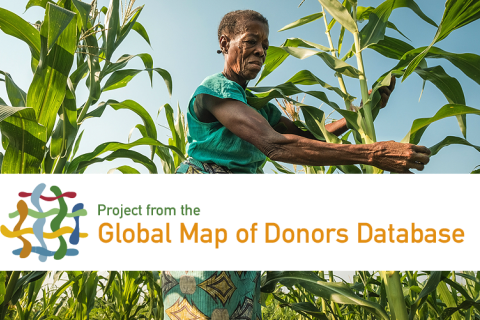The Global Donor Platform for Rural Development is a network of 38 bilateral and multilateral donors, international financing institutions, intergovernmental organisations and development agencies.
Members share a common vision that agriculture and rural development is central to poverty reduction, and a conviction that sustainable and efficient development requires a coordinated global approach.
Following years of relative decline in public investment in the sector, the Platform was created in 2003 to increase and improve the quality of development assistance in agriculture, rural development and food security.
// Agriculture is the key to poverty reduction
Agriculture, rural development, and food security provide the best opportunity for donors and partner country governments to leverage their efforts in the fight against poverty.
However, the potential of agriculture, rural development and food security to reduce poverty is poorly understood and underestimated.
Cutting-edge knowledge of these issues is often scattered among organisations, leading to competition, duplication of efforts, and delays in the uptake of best practices.
// Addressing aid effectiveness
Therefore the Platform promotes the principles of the Paris Declaration on Aid Effectiveness, the Accra Agenda for Action for sustainable outcomes on the ground, and the Busan Global Partnership for Effective Development Cooperation.
Increasing aid to agriculture and rural development is not enough. Donors must work together to maximise development impact.
// Adding value
The Platform adds value to its members’ efforts by facilitating the exchange of their development know-how, which consolidates into a robust knowledge base for joint advocacy work.
Working with the Platform, members are searching for new ways to improve the impact of aid in agriculture and rural development.
- An increased share of official development assistance going towards rural development
- Measurable progress in the implementation of aid effectiveness principles
- Greater use of programme-based and sector-wide approaches
- More sustainable support to ARD by member agencies
// Vision
The Platform endorses and works towards the common objectives of its member institutions to support the reduction of poverty in developing countries and enhance sustainable economic growth in rural areas.
Its vision is to be a collective, recognised and influential voice, adding value to and reinforcing the goals of aid effectiveness in the agricultural and rural development strategies and actions of member organisations in support of partner countries.
// Evaluation
Between August and October 2014, the Global Donor Platform for Rural Development underwent an Evaluation. The evaluators interviewed across board focal points (FPs) of member organisations, partner institutions, staff of the secretariat and key agricultural and rural development experts from different organisations involved in the Platform initiatives. KIT reviewed Platform documentation of the past 10 years, online resources and services to complete the assessment.
According to the report, the change in overall global development objectives of the Post-2015 agenda and its sustainable development goals (SDG) will only reiterate the relevance of the Platform’s work in coordinating donor activities. Agriculture and rural development are incorporated in many of the SDGs. The targeted development of appropriate policies and innovative strategies will depend on increased, cross-sectoral cooperation which the Platform stands for. The achievement of the Platform’s objectives of advocacy, knowledge sharing and network facilitation functions remains to be a crucial contribution to agriculture and rural development.
Members:
Resources
Displaying 241 - 245 of 809Community-based sustainable management of Tanguar Hoar
General
Decentralized co-management system conserves ecosystem values and services and provides a basis for improving rural livelihoods
Sir Ratan Tata Trust
General
Omidyar Network partnered with Tata Trusts to map the Odisha slum’s informal settlements and to identify 100,0000 households eligible to benefit from the recent Odisha Land Rights to Slum Dwellers Act, which aims to identify, map, and issue titles for parcels of land currently occupied by slum households. The urban slum titling project utilizes specialized resources in drone technology, geospatial mapping and machine learning. Odisha is the second largest slum in India and the partnership provided households with property titles, otherwise known as “patta”. With patta, individuals can have access to secure benefits like education and bank accounts. Learn more about why we partnered with Tata Trusts on this project
Addresses for people and businesses in Kosovo
General
The Project aims at supporting efficient first time giving out and subsequent maintenace of road addresses throughout Kosovo, by building vital components of electronic address registers and related information services
SNV: Forestry programme in Albania
General
promoting decentralised decision making and planning in forest and pasture land and further strengthening the relationship between local government and forest communities.
Delivery of Advisory Services for the Communal Land Development Project
General
The CLDP project is implemented as an integral part of the PCLD and is structured along a series of causally interlinked activities. Existing customary land rights and infrastructure will be mapped and registered in a designated Namibian Communal Land Administration System (NCLAS). The information provided by this system will be used during the planning phase where, depending on the complexity of an area, an Integrated Regional Land Use Plan (IRLUP) or initially only a Local Level Participatory Plan (LLPP) will be developed. This will result in the registration of legitimate existing land rights, as mapped and validated in the first step, as well as the registration of “new” land rights which emanate from and are defined in the participatory planning process. These land rights can accrue to individuals as well as to groups of people, and are an important step towards securing the remaining commonage in the interest of more marginalised rural residents, as well as creating a conducive environment for private investments on the land. Planning for, and investments in infrastructure developments, will explore a mix of potential interventions which make provisions for different ownership, management and land use options to stimulate diversification options. Advisory services will strengthen both the planning phase, as well as the optimal utilisation of the infrastructure investments in order foster the integration of rural communities in the mainstream economy.


